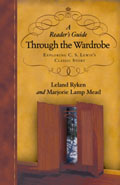
Leland Ryken and Marjorie Lamp Mead
Reviewed by: Hazel Kessler
A Reader's Guide through the Wardrobe: Exploring C. S. Lewis's Classic Story, by Leland Ryken and Marjorie Lamp Mead. Published by InterVarsity Press, 2005. Paperback, 192 pages, list price $15.00. Reviewed by Hazel Kessler, a member of Grace OPC in Columbus, Ohio.
For a guided tour through The Lion, the Witch and the Wardrobe (LWW), Leland Ryken and Marjorie Lamp Mead lend their scholarship and their candid approbation of C. S. Lewis. The writers, both from Wheaton College, borrow Lewis's own lantern of literary criticism to lead the way. They begin with a warranted caution: their guide must not precede a first-time reading of LWW that engenders the wonder, the sheer delight, of following the Pevensie children into Narnia. Writing A Reader's Guide through the Wardrobe for serious readers, Ryken and Mead wisely follow Lewis's own pattern and advice, as a renowned critic, for gaining the profound enjoyment of reading at a "sophisticated literary level." Ryken and Mead recognize that an author as skilled as this Oxford don brings all his life experiences and pursuits to bear on the imaginary world he creates.
Ryken and Mead divide their companion work into two parts. Part 1 is "A GuidedTour of The Lion, the Witch and the Wardrobe," with each of the eighteen chapters corresponding to the chapters of LWW. Each chapter looks at the various literary elements of Lewis's fantasy. The authors guide us through the archetypal patterns, the images and motifs he uses, and "the impressive range of literary genres that converge" in the story. By the time we reach the end of Part 1, we have looked at romance and myth, the quest, and the evil witch archetype. They point out the particular power of Lewis's style, plot, characterization, and setting.
Chapter 9 offers an apologetic for images of evil in children's literature. The authors also anticipate our questions. What inspired the idea of the wardrobe? Is Turkish Delight a real candy? Interspersed boxed sections provide inviting information or prompts for further thought.
Following a selection of Lewis photographs, Part 2 of the guide deals with "Narnian Backgrounds." Ryken and Mead discuss how The Chronicles of Narnia came into being and what is the best order for reading them. Part 2 also considers the critical responses to The Chronicles, from the scathing condemnation of Lewis's "picture of Christ at the playground putting weapons into the hands of children," to charges of sexism and occultism, to the more pervasive response that Francis Spufford voices: "Lewis gave forms to my longing ... he anticipated what would delight me with an almost unearthly intimacy." Ryken and Mead follow with an analysis of the valued Christian vision of LWW embodied in unforgettable images, an element that, Lewis said, "pushed itself in of its own accord." They conclude with a short biography of Lewis.
The authors' scholarship and ability to inspire join to lead us through the story of an alternate world, keeping both a child's wonder and an adult's profound reflection.
November 16, 2025
November 09, 2025
November 02, 2025
October 26, 2025
October 19, 2025
October 05, 2025
Raising Sexually Faithful Kids and
Parenting Boys and Girls in a Gender-Confused World
September 28, 2025
© 2025 The Orthodox Presbyterian Church